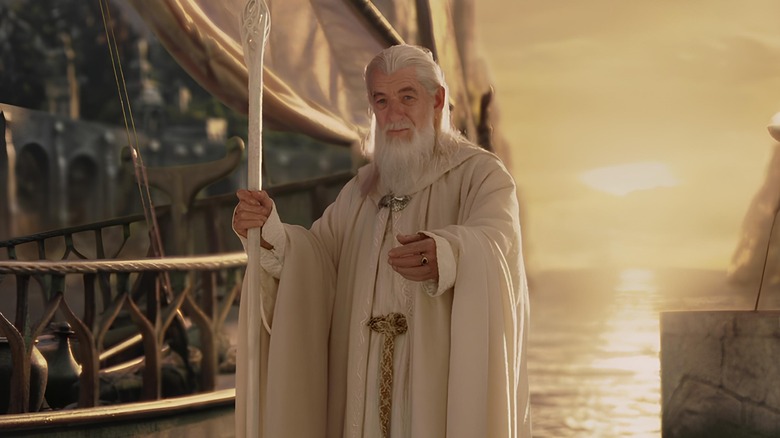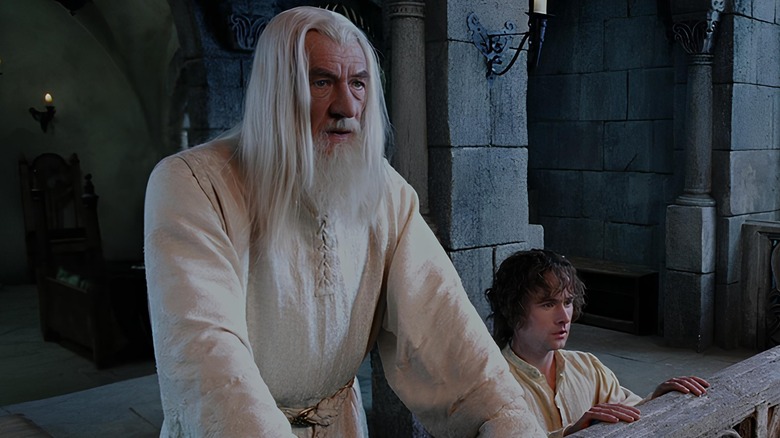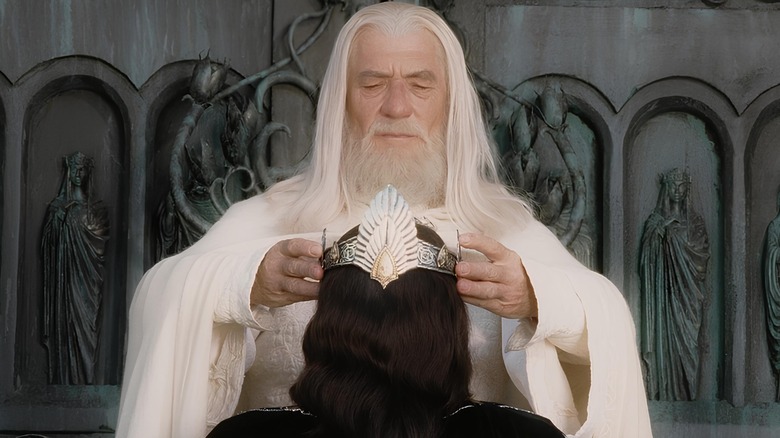Lord Of The Rings: Gandalf's Ending After Sauron's Defeat Explained - Did He Die?
Peter Jackson's "The Lord of the Rings" trilogy is often teased for cramming six or seven conclusions into the last film as if J. R. R. Tolkien didn't create almost a thousand named characters with almost as many unique endings in his complete body of written work. And while only a fraction of that exhaustive number appears in the six-part novel (no, seriously, Tolkien's legendary story is technically six parts published in the three books that comprise one epic), there are entire swathes of information that didn't make it into Jackson's theatrical cut, let alone the extended cuts – the latter of which features almost three additional hours of footage.
So, for instance, while viewers know that Gandalf the White (Ian McKellan) leaves Middle-earth on an elven boat with Frodo Baggins (Elijah Woods), Bilbo Baggins (Ian Holm), Elrond (Hugo Weaving), and Galadriel (Cate Blanchett) by his side, it's not immediately clear what happens to him afterward. Where is he now? Is he still alive? The short answer is that, presumably, Gandalf is still alive on the sandy beaches of Elf Heaven, blowing magical smoke rings from his wizard pipe and laughing at Bilbo's meandering jokes.
The slightly longer answer involves a bit more exposition and a hearty dose of Tolkien-centric verbiage, but that's the stuff that fantasy lore lovers thrive upon, isn't it? Here's everything we know about the ending of Gandalf's long journey.
Gandalf is basically an earth-bound angel
Gandalf describes death in "Return of the King" as "Just another path, one that we all must take. The grey rain curtain of this world rolls back, and all turns to silver glass, and then you see it ... White shores, and beyond, a far green country under a swift sunrise." The imagery he uses is notably similar to the lyrics of "Into the West," a song written for the film that underscores both his beautiful speech and the film's final ending, the one which sees Gandalf and company depart Middle-earth from the crystal clear shores of the Grey Havens. All this is to say that it would be understandable for some to consider this moment to symbolize Gandalf's death. And yet, that's not quite what's happening here.
Gandalf is not human; he's one of the Maiar, and this is where the Tolkien terminology begins. The Maiar are primordial spirits created by Eru Ilúvatar, Tolkien's Capital "G" deity. Gandalf, Saruman the White (Christopher Lee), and a few others were given physical form and sent to Arda — Earth — to guide life in the proper direction. Known to most as wizards and to the Elves as Istari, it's best to think of Gandalf and his primordial compatriots as lesser angels. Because Gandalf can technically die — he sort of did in "Fellowship of the Ring" — just not in the same way that most can.
When Gandalf sails away from Middle-earth in "Return of the King," he isn't dying. That said, he is going to Valinor, aka Elf Heaven.
Gandalf heralded the next age before leaving
Valinor is known to many as the Undying Lands because it is where the elves migrate during the Third Age, and the lives of elves only end if they are taken by another's hand. Otherwise, they live without finality. Valinor is also on the continent of Aman, a land beyond the seas of Middle-earth that is only reachable to those who have bid their first lives goodbye. Which, again, kind of sounds like maybe Gandalf had to die to get there. But Valinor, unlike the Heaven of J. R. R. Tolkien's Catholic faith, does not seem to require a literal death so much as a figurative one for entry. So long as the life that came before is left behind, Aman and its countries are available to those who seek it out.
And after the defeat of Sauron, Gandalf's task on Middle-earth is done. It is not his to guide the next age, nor is it his to shepherd its people. His final acts include crowning Aragorn (Viggo Mortensen) as the rightful king of Gondor and officiating his wedding to Arwen (Liv Tyler). There is also a two-year gap between Sauron's fall and Gandalf's final goodbye, in which all that is known of the wizard's deeds is that he spent some time with Tom Bombadil, Middle-earth's strangest entity. All else known is that Gandalf wears Narya (one of the elven rings of power), and when he departs, he is joined by Shadowfax, the great horse, in his final moments. Unfortunately, Tolkien's writings do not clarify whether Shadowfax travels across the sea.
As we mentioned before, Gandalf is still presumably enjoying eternal peace in the Undying Lands. As is his right.


